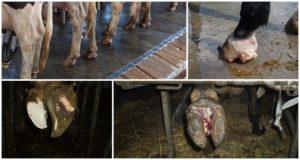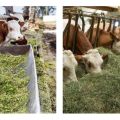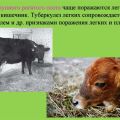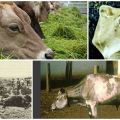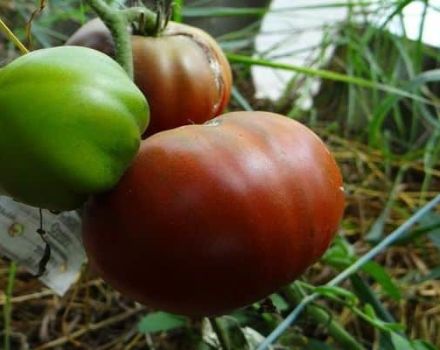Rules for transporting cows and what kind of transport to choose, the necessary documentation
Correct transportation of livestock is one of the important conditions for livestock farming. The transportation of cows, bulls, calves is organized so that in the process of moving the animals do not get injured, do not lower their physical condition. Even if they are sent for slaughter, transportation in violation of the established rules will lead to a decrease in the weight of the animals and a deterioration in the quality of the final product.
Basic rules for the transportation of cattle
Animals can be transported by road, by rail, by waterways. Most often, transportation is carried out by cars or livestock trucks. When moving cattle, you must follow the rules:
- It is advisable to transport livestock on highways. The smooth road will allow you to carry the load without painful "bouncing" of the car. Move smoothly, without jerking.
- In cold weather, maintain the temperature inside the body in the range of 12-16 ° C with a humidity of 70%. In the warm season, temperatures up to 30 ° C and humidity up to 60% are considered favorable. If the temperature rises, then it is worth turning on ventilation at a speed of up to 0.3 m / s. Do not transport livestock in high temperature and humidity conditions. In this case, it is better to move around at night.
- If you have a long trip, then every 6-8 hours it is necessary to stop and check the availability of food and water, the physical condition of the animals. Every 10-14 hours, take a break, taking cattle out of the transport. At the halt, feed the animals and give them a rest.
- Milk cows at least once every 12 hours.
- Separate adult animals from each other with strong partitions and securely fix. Young animals can be tied more loosely, but take into account the area of the vehicle so that the calves can lie down freely on the floor. Place bulls at a safe distance from each other. Bulls and cows cannot be transported in the same vehicle.
Calves can be transported standing or lying, depending on the duration of transport. Also, for each adult cattle, you need to calculate the amount of food and water. The tables show the allowed parameters.
| Cows and bulls | |
| Food, 1 day | Water, 1 day |
| 2 kilograms of hay per 100 kilograms of weight | 10-50 liters of water per individual depending on the ambient temperature and age |
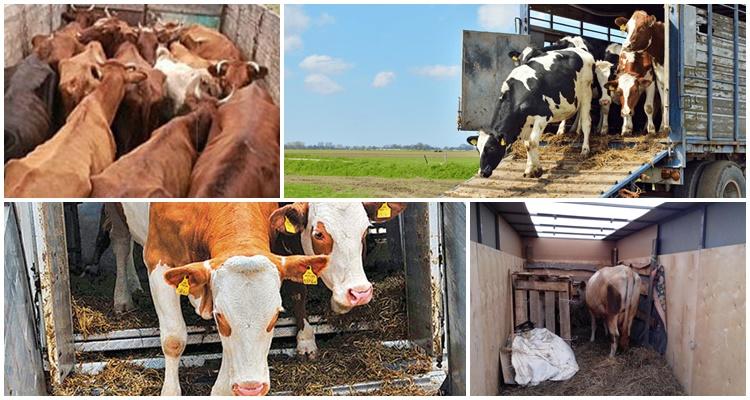
| Calves | |
| Transportation time | Piglet area for 1 calf |
| 3-5 hours | 0.3 m2standing position |
| 6-8 hours | 0.5-0.6 m2lying position |
Adhering to these rules, you can take animals to their destination without prejudice to their health.
Recommendations for preparation for transportation
Before the trip, you need to carry out preparatory measures. To transport animals without complications, it is advisable to first perform the following steps:
- Check the health of the livestock after passing the veterinary and sanitary control. Also, a month before the intended transportation, complete the entire complex of veterinary procedures, including the necessary vaccinations.
- For a long trip, one month before the start, introduce into the diet of animals the feed that will be used for transportation. This will help to avoid gastrointestinal dysfunction on the road.
- Based on the weather forecast, choose a day with favorable climatic conditions.
- Prepare a detailed route plan and calculate the time.
- If there are halts along the way, then provide resting places with high-quality hay and water.
- Check the operation of the temperature control system. Ensure that drinking apparatus is clean.
- Collect all the necessary documents.
Animals must be well fed and well rested before traveling. The hair of the animals is cleaned with a brush. The hooves should be treated with 5% formaldehyde solution or 10% copper sulfate. Also provide for fast loading and unloading of livestock.
Loading and unloading
When loading and unloading, it is necessary to use gangways, ladders with fences on the sides. The bridges should not be slippery; in addition, they can be equipped with profiles for better grip. Must have a slope of no more than 30 °.
The corral should be carried out during the daytime. If the procedure will take place at night, then provide good lighting. Same-sex animals are herded into one car, otherwise a strong partition is established between the females and males.
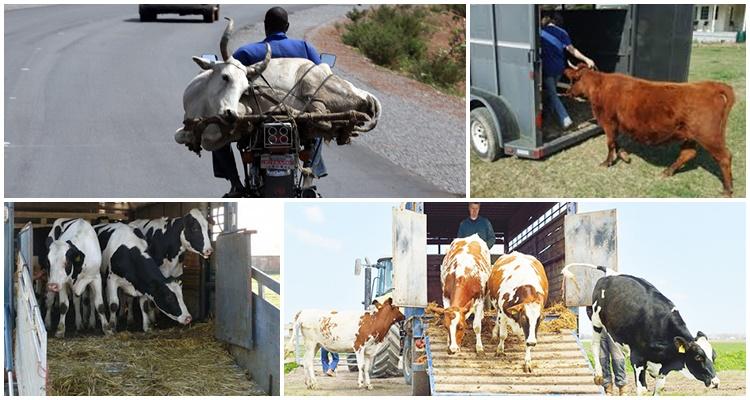
Transport for moving cattle
Most of the transportation within the country is carried out by road. Livestock trucks can move large numbers of animals. They provide all the conditions for the careful transportation of livestock:
- there are heating and ventilation systems;
- separate pens for animals with sturdy partitions;
- systems for automatic collection of manure, drinking apparatus;
- lighting that allows you to monitor the condition of animals;
- in a covered car, ventilation hatches in the floor are provided for the removal of gaseous products of animal life.
If you need to transport several animals, then use small specialized Gazelle vehicles. For example, cows in a gazelle can comfortably drive to a remote location. The distance can be up to 1000 kilometers. It is convenient to use such vehicles if you need to transport livestock from your personal subsidiary farm.
Documentation authorizing the transportation of cattle
Transportation of cattle is regulated by legislative acts. All approvals and certifications must be obtained to avoid shipping problems. If animals are to be moved to another region of Russia or abroad, then the following documents are required:
- waybill and waybill;
- veterinary certificate and certificate of the State Veterinary Inspectorate, permitting the transportation of cattle;
- sanitary passports of animals and a veterinarian's conclusion issued before shipment;
- for export outside Russia, you need a permit from the Ministry of Agriculture and transit documents.
To move within the district, it is enough to have a veterinary passport, a certificate issued in accordance with Form 1, and a permit for transportation from the chief veterinarian of the district.
For the transportation of cattle, it is better to contact companies specializing in this type activities. A car unprepared for transportation can cause large financial losses. Before transporting cows or bulls, it is necessary to prepare the accompanying documentation.
